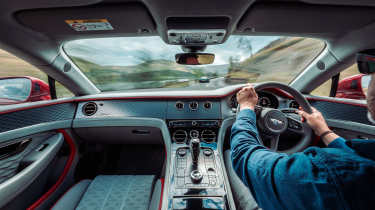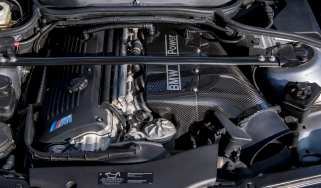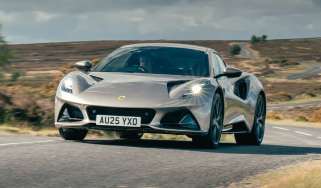Bentley Continental GT Speed v Aston Martin DB12 v Maserati GranTurismo – which is the ultimate grand tourer?
We pitch the new Bentley Continental GT Speed against the 671bhp Aston Martin DB12 and the MC20-engined Maserati GranTurismo Trofeo
What is a GT? Four hours after setting off, I think I’ve got a pretty good idea, and it’s Bentley Continental GT Speed-shaped. More than 220 miles have passed beneath its huge wheels, occasionally very quickly, yet getting out I feel as fresh as when I slipped in. The ability to cover vast distances effortlessly is the hallmark of a true GT and from the moment you swing open the door, the Bentley promises that. The light grey and red ‘Hotspur’ contrast trim might not be the colours I’d choose, but you’re greeted by a reassuring plushness, deep carpet underfoot and soft suede welcoming you into the seat. Gently pull the door to – a motor finishes the job – and then there’s a slightly surreal quietness, the bustle of the outside world muted, almost like you’ve slipped on a pair of noise-cancelling headphones.
I heard the Conti arrive even before it turned into my street, its engine note a heavy pulse like a big-capacity V-twin motorbike or a motor cruiser, but when I push the start button I wonder for a moment why nothing has happened. It’s because the default drive mode – ‘B’ for Bentley – starts the Conti in EV mode. Now I recall the delivery driver saying he’d driven here in Sport because it charges the hybrid system and he wanted to deliver the car with a full battery as well as a full fuel tank so that all 771bhp (count ’em!) would be available, the individual peak outputs being 591bhp from the 4-litre, twin-turbo V8 and 188bhp from the e-motor.
There’s a plushness to the way the Conti GT Speed drives, too. The ride over choppy town roads is remarkably supple, facilitated partly by the new electronically controlled, two-valve dampers (on two-chamber air springs), partly by the active anti-roll bars that decouple when not required, allowing more individual wheel articulation. You’d never guess it was riding on 22-inch wheels wearing 275/35 Pirelli P Zeros up front and even bigger 315/30s at the rear.
More reviews
In-depth reviews
Reviews
- Bentley Continental GT 2025 review – Crewe's DB12 rival has the Aston Martin licked
- Bentley Continental GT Speed 2025 review – driving the most powerful Bentley yet
- Bentley Continental GTC Speed 2025 review – huge power, huge weight, huge price
- Bentley Continental GT W12 (Mk1, 2003-2010): the car that saved Bentley
- New Bentley Continental GT hybrid prototype review: Bentley’s most powerful road car ever
- Bentley Continental GT S 2023 review
It is a very refined car, that sense of isolation holding on the A1, with no wind noise to speak of and road noise only over certain coarse surfaces. It’s a restrained run north, more than an hour of it behind a wide load at 50mph, followed by a bit of a dash across country for the final leg of the journey. The default drive mode doesn’t actively charge the battery but slips into EV mode whenever possible, and if you ease off at motorway speeds you can watch the revs drop to zero and feel it ‘sailing’, everything in neutral, which has got to help economy. A top-up reveals it’s almost 34mpg for the run, which seems good going for a near-2400kg car with so much performance.
Of course, the desire to feel all 771bhp is impossible to resist. Off the motorway, I select Sport mode and the V8 bursts instantly into life, like a WEC Hypercar at the pit exit, before settling to a bass-heavy idle that sounds much quieter from inside than it did from outside. Over a wider variety of surfaces, the big wheels and tyres occasionally feel like they’re just getting the better of the dampers, and over some crests the nose seems to hang there, but most of the time the Bentley feels composed, solid. When the opportunity arises, all 771 horsepower and 738lb ft (1000Nm) of torque are delivered unflinchingly and the Conti launches forward with a force that feels like it should register on the Richter scale. There’s something primeval about the way a heavy car with enormous performance takes off, a mix of excitement and terror, like looking over a sheer drop.
By the time I arrive in Hexham, it’s pretty clear that the Conti has cornering grip to match its traction, assisted again by active anti-roll bars that limit roll, and rear-wheel steering that helps rotate the car into turns. Both are really well judged, quietly enhancing the drive rather than drawing attention to the technology. Add in humungous (and, surprisingly, optional) carbon-silicon-carbide brakes that keep the mass in check and you’ve got a remarkably capable GT.
It’s got some pedigree competition, though, in the shape of the Maserati GranTurismo Trofeo and Aston Martin DB12 (the Ferrari Roma is absent because a new version is due shortly). There’s no question that, of the trio, the Aston is far and away the most attractive shape here, even though it’s not in its most fetching trim, having a dark roof and wheels. The Conti GT has been with us for two decades, always evolving but, in our collective view, not really improving in style. Alongside the sleek, low-slung DB12, it looks like a slab of a car. All credit to Aston Martin, though: the DB12 was derived from the gawky DB11, a transformation nearly as miraculous as Ferrari 348 to 355.
The GranTurismo is even lower but less seductively proportioned. In a similar shade of red to the Conti, it looks a bit like the Bentley after it’s been under a rolling pin. Lower, longer and feeling wider and more spacious inside than either of the other cars, the Maserati accommodates four better than the Bentley and certainly much better than the Aston, which has rear seats technically, not practically. In proportion, the GranTurismo reminds me of the Ferrari 612 Scaglietti, which was designed to have the same, slightly rear-biased weight distribution as the company’s mid-engined supercars.
The first thing to note is that, compared with the Bentley, the non-hybrid Maserati and Aston are substantially lighter, by nearly 600kg, both coming in at just under 1800kg. The Bentley has never been a light car and hybridisation has added another 110kg, which is how, despite having a steel and aluminium monocoque clad in superformed aluminium panels, its kerb weight now sits at 2384kg. Thing is, for overcoming inertia there’s nothing quite as effective as an electric motor, because it delivers maximum torque from zero revs, which is how the Conti GT achieves a frankly jaw-dropping 0-62mph of 3.2sec. With the twin-turbo V8 blowing hard, it gets to 100mph in under 7sec and tops out at 208mph. That’s full-on supercar performance in a GT.
The Aston and Maserati can’t match the Conti’s pace off the line but neither is what you’d describe as shabby. With a 542bhp version of the MC20’s ‘Nettuno’ twin-turbo V6 under its clamshell hood, the GranTurismo’s power-to-weight ratio is not far off the Conti’s: 307 versus 329bhp per ton. It has four-wheel drive too, which is how it pips the Aston to 62mph (3.5 versus 3.6sec), even though the DB12’s 671bhp, twin-turbo V8 gives it the best power-to-weight ratio here, a massive 381bhp per ton.
After the Bentley, dropping into the Aston’s seat is like dropping into another world. There’s lots to like about the Bentley but for some tastes it’s a little bling: some familiar Volkswagen Group switchgear Bentley-fied with shiny knurled detailing, the faux machine-turned facia trim… There are plenty of options for a subtler look of course, but the Aston’s clean, simple, tidily detailed facia is the epitome of restrained style. There are a few jarring details, notably the dated switches for seat and mirror adjustment and some of the type sizes used in the instruments and centre screen, which are far too small, but you’ve dropped low into a seat that wraps comfortably around you and a push of the starter button rouses the V8 with a flourish of revs and a purposeful rumble.
Roll away and immediately everything’s more connected, more instantaneous. Brake response is top-of-the-pedal sharp, steering response immediate, and even in start-up ‘GT’ mode the ride is obviously firmer. You can feel the lateral stiffness and there’s definitely more sensation of hitting bumps as well, the audible report stronger, particularly from the broad rear Michelins. This responsiveness extends to the handling. There’s an inherent agility to the DB12; even at a moderate pace it wants to rotate into corners, the front end super-positive. Pick up the power at the apex and it’s obvious it’s the back end that’s doing the pushing: the Aston is dynamically unambiguous. But if you’re to exploit the considerable grip and massive performance, you need to relax your inputs a little and dial into it. Do that and the DB12 really starts to flow.
The Aston’s V8 doesn’t deliver the instant response of the Bentley’s hybrid powertrain but it’s a thrilling thing when you give it its head. Strong in the mid-range, it revs with a lightness and eagerness that feels and sounds more flat-plane crank than traditional V8. The gearbox, an eight-speed ZF auto, feels out of step with the engine – and the rest of the car – by being soft-shifting and relaxed about it too, so if you want to pick up the pace cross-country it’s best to go manual and use the classy carbon paddles. The other slightly anomalous part of the DB12 is its inability to deal with certain mottled road surfaces, which bring a cacophony of clatters and trim rattles that are quite unexpected in a brand new, near-£200k car.
Dickie Meaden has just stepped out of the Maserati. ‘I love the powertrain. It’s really quite a charismatic thing; super, super powerful. It’s really quite mellow and muscular in the low- and mid-range but then goes like the clappers at the top end. Sounds good too. The gearshifts are really well rounded and there’s something quite satisfying about the weighting of the paddles, so it just all fits together quite nicely. So that’s good...’ he says, and then wanders off. The rest, it seems, is for me to discover.
We have met before. The GranTurismo was at eCoty 2023 in the cold, wet Borders, and copped a bit of flack, but so too did the DB12. I actually thought it a slightly better GT than the Aston by dint of offering greater bandwidth of ride quality. In terms of base price it’s the least expensive car here, though with 542bhp it’s also the least powerful by quite a margin, and it’s a couple of cylinders short.
After the others, the remarkably low-slung Maserati feels spacious. The overall design and execution of its interior is fine but some of the details are disappointing, notably the fillet of dashboard trim that looks like 3D-printed plastic. If we’re being honest, of more concern is the ill-conceived centre screen and switchgear. Push-buttons for gear selection? Selecting gears as you might choose chocolate from a vending machine is not a premium experience. Worse than that, below the main screen is another touchscreen for heating and ventilation, which means you have to take your eyes off the road and look down to make adjustments. Worse still, you also have to navigate the screen for the main light switch. Other oddities are buttons instead of interior door handles and a start button that’s blue when everyone else’s is red.
On the plus side, the simple, thin-rimmed steering wheel feels best in your hands and promises detail and precision. Rolling away, there’s a suppleness to the ride that suggests the Maserati might be the best of both worlds, offering the ride comfort and traction of the Bentley with the agile, crisp handling of the Aston.
As with the DB12, the GranTurismo’s default mode from start-up is GT, but it’s much softer. In fact, the Maserati’s most extreme mode, Corsa, is probably on a par with the Aston’s GT mode. However, like power, suppleness is nothing without control and at times the GranTurismo is somewhat lacking, the wheels shimmying in the arches over sharp bumps. Even when you shift up to Sport or Corsa, it’s not as well tied-down as you’d hope, as if the body structure isn’t providing the solid platform required for really firm inputs.
Traction is impressive and it’s not obviously four-wheel drive, the steering never corrupted by torque at the front wheels. If anything, it feels as rear-drive as the Aston; you can occasionally feel the rear jink out powering out of tight corners. Feedback isn’t as positive as in the Aston and on undulating roads that the others traverse confidently, the low-riding – even lower-riding if you’ve selected Corsa mode – GranTurismo feels at risk of scraping its underside. Then you find a compression abrupt enough, and it does.
This is a shame because the Maserati does feel lighter and more naturally agile than the Bentley, and it has a superb engine. In all honesty, the 3-litre V6 doesn’t feel any less potent than the V8s and revs out with greater enthusiasm. It’s a lusty engine that oozes torque and character. Pin the throttle, feel the boost build and the torque swell and enjoy the addictive sensation of the GranTurismo riding a wave of thrust that grows in intensity as it nears the red line. It sounds great, too, a classy, smooth V6 burr that makes the hard-revving V8s sound gritty and workmanlike, and its shifts are much more positive and satisfying than the Aston’s.
Dickie has just had his first taste of the Bentley. ‘It does that super-luxury effortless performance thing really well,’ he says, ‘but with the hybrid it’s got this extra dimension of speed which is pretty breathtaking, but it doesn’t feel like it’s too fast for its own good. It’s quite playful in the lower-speed corners but has stability through the higher-speed corners.’ He’s impressed with its refinement, too, having got used to the road noise of the Aston on the way up. ‘You get into the Bentley and think, blimey, this is quiet.’
‘I’m surprised at how little it sounds like an AMG V8,’ says senior staff writer Sam Jenkins, pondering the Aston. ‘It has its own unique character, more of the guttural edge of the old naturally aspirated V12s. The steering is quick and direct too, but on the worst roads the chassis is not quite as sophisticated as you’d like, but then it keeps the bodywork off the floor, unlike the Maserati...’
Slipping back into the Bentley, I’m surprised how different it feels after the Aston and Maserati. I’m more aware of the loftier driving position, the blunter responses and the more damped feedback, all of which make it feel like a quasi-SUV. It’s a feeling that it can’t quite shake, but half a mile into a demanding stretch of road it’s clear once again that none of it is a hindrance to making progress. Sure, this 2.4-ton GT relies on the interventions of its clever systems to play give-and-take with the more nimble Aston and Maserati, but it absolutely can, and that is astonishing. At the wheel you occasionally feel like a witness to the rules of physics being defied.
As a pure driving tool, the Bentley unquestionably lacks the edge of its rivals here, but it’s remarkable how much of its performance you can deploy and how hooked-up and on-line it stays, even when you’re pushing very hard. The front tyres complain first, squealing a bit but still not scribing a wider arc than you’ve steered. Shout-out to Pirelli, supplier of the tyre that tolerates the extreme loads the Bentley can generate. The greater the pace, the more you notice the mass up front, and eventually having the whole V8 ahead of the front axle line cannot be disguised. Lift the bonnet of the Aston or Maserati and their engines are wholly behind the front axle line, so the Bentley V8 would fit in the space ahead of them, which is an amusing thought.
For the next leg I’m in the Aston and it’s a definitive 40 minutes, the best I’ve enjoyed in a DB12. In the late afternoon sun, the roads jink and dive, corners often late-sighted, but the Aston seems to find its sweet spot early on and stays in it, for miles. Soft hands on the open, flowing sections and quick but measured inputs in the tighter stuff produce a very satisfying, brisk flow. There’s plenty of low-down performance but the V8 enjoys high revs too, its light, flat-plane-like bark and strong response giving it the feel of an eager, naturally aspirated engine. There isn’t fantastic feedback through the wheel but you can be precise, the car changing direction crisply, front-end grip seemingly undefeatable. And even though all 671bhp goes to the back, unless you go out of your way to provoke it, the rear stays nailed.
The Maserati, with its major masses in the same place and being similarly low-slung, should be capable of producing the same degree of engagement and dynamic clarity, and to a degree it does. Again, the drivetrain is the star of the show, the characterful V6 delivering generously, with less turbo lag than the Aston too. And although it’s the only car here on iron discs, it gives nothing away in feel or performance to the others. Trouble is, having felt it run out of travel a couple of times, I’m wary of carrying speed because these Northumberland roads throw up the occasional big dip or crest without warning.
There’s lots to like about the Maserati but it trails the other pair. It deserves credit for being the most accommodating four-seater, and its terrific V6 drivetrain has more quality and character than the V8s it’s ranged against. It feels so much stronger than its quoted numbers that you could believe it has the same 621bhp the MC20. It’s a shame it doesn’t have the chassis to match.
‘My main bugbear is the suspension,’ says Dickie. ‘It doesn’t feel consistent or particularly well resolved, and it has those complete lapses of body control sometimes so you can’t quite trust it. I also found the handling balance a little bit dull. You can’t quite extract what you feel it should be capable of.’
On the other hand, the Bentley is a remarkable car. You get the feeling that the engineers sat down in a room, decided what the targets were, selected the tech they needed to achieve them, and then went and nailed every one. Hybridisation suits it very well too, adding the ability to cruise silently at one end and ludicrous performance at the other. Yes, it adds even more weight, but the Conti was already well over two tons.
‘The Bentley is massively impressive,’ says Dickie. ‘I think the hybrid adds a lot more than it takes away. The quality is there and the comfort. The interior is not to my taste but I accept that you could tailor the colour and trim choices more to your liking. As a thing to drive and a thing to be in, it’s hugely convincing. As a thing to covet? I’m not so sure.’
The Aston swivels heads wherever it goes and it’s as attractive on the inside as the outside. It’s a quite different proposition to the Bentley, not least being only a token four-seater. More than that, there’s a focus to it that makes it a quite narrow definition of a GT, something Aston itself alludes to, describing the DB12 as a Super Tourer, a portmanteau of supercar and grand tourer.
‘The Aston is the other extreme really,’ says Dickie. ‘The Bentley does luxury and effortless performance really well, while the Aston is by far the most exciting and most sporting of the three cars, and that’s to its credit, but it’s also to its detriment. I love its responsiveness. For me, it’s just the right side of being too alert; you can relax with it. If you want a really sharp sports car feel, that’s absolutely what it delivers.’
What the Aston doesn’t have is the Bentley’s roominess, its deep sense of quality or its refinement. Or its bandwidth. What the Conti lacks in dynamic clarity and innate athleticism, it makes up for with brilliant tech, artfully deployed. It will get down a challenging road as fast as you could ever want to go, carving confidently through turns and sweeps, and its straight-line performance is awe-inspiring. It can then slip silently through town, cosseting its passengers, or you can point it down a motorway and know that four hours later you’ll step out feeling fresh. Ask the internet ‘What is a GT’ and the first thing you see should be the new Continental GT Speed. L














